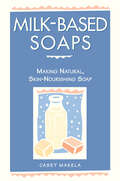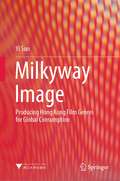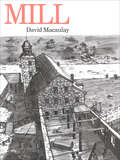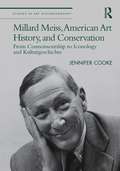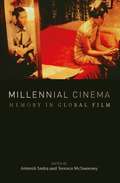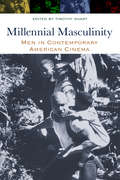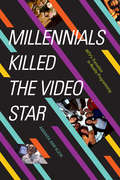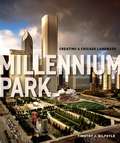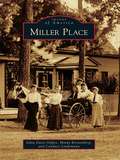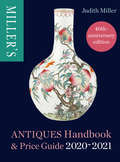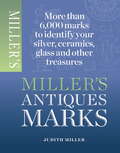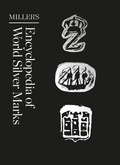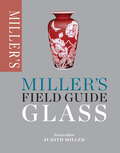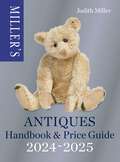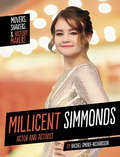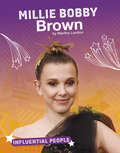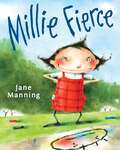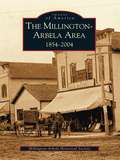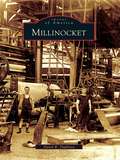- Table View
- List View
Milk-Based Soaps: Making Natural, Skin-Nourishing Soap
by Casey MakelaCraft beautiful, sweet-smelling milk-based soaps safely and easily. In this fun and informative guide, Casey Makela shares her specialized techniques for producing lusciously creamy soaps. With straightforward instructions and thorough explanations, Makela teaches you how to fashion your own soaps from vegetable oils and tallow bases, giving dozens of suggestions for relaxing scents and specialty colors that will let your product shine. You’ll soon be creating enticingly unique soaps that will keep your glowing skin smelling and feeling good all day.
Milkyway Image: Producing Hong Kong Film Genres for Global Consumption
by Yi SunThis book adopts an integrative research framework that primarily combines industrial and discourse analysis to investigate the company Milkyway Image, drawing upon literature that studies film studios and the practices of film production, distribution, and reception. The history of the Hong Kong-based film production company Milkyway Image from its founding in 1996 to the present exemplifies the metamorphosis of the post-return Hong Kong film industry to an era characterised by Hong Kong’s integration into a Chinese national context and the transnationalisation of world cinema. It shows that contemporary Hong Kong cinema’s transition resists a monolithic chronicle and instead represents a narrative combining the perspectives of different interest groups and a complex process of compliance and resistance, negotiation and contestation. The meaning of Milkyway’s films shifts as they are circulated across cultures and viewed within diverse frameworks, and our understanding of Hong Kong cinema is subject to varying contexts and historical configurations. For researchers in film and media studies and those who have a general interest in Hong Kong cinema, Asian cinema, or contemporary film culture, this book reveals how a variety of industry and cultural bodies have become co-creators of meaning for a film production house, and how the company operates as a co-creator of the discourse that surrounds it.
Mill
by David MacaulayThe mills at Wicksbridge are imaginary, but their planning, construction, and operation are quite typical of mills developed in New England throughout the nineteenth century.
Millard Meiss, American Art History, and Conservation: From Connoisseurship to Iconology and Kulturgeschichte (Studies in Art Historiography)
by Jennifer CookeA member of the art history generation from the golden age of the 1920s and 1930s, Millard Meiss (1904–1975) developed a new and multi-faceted methodological approach. This book lays the foundation for a reassessment of this key figure in post-war American and international art history. The book analyses his work alongside that of contemporary art historians, considering both those who influenced him and those who were receptive to his research. Jennifer Cooke uses extensive archival material to give Meiss the critical consideration that his extensive and important art historical, restoration and conservation work deserves. This book will be of interest to scholars in art history, historiography and heritage management and conservation.
Millennial Cinema: Memory in Global Film
by Amresh Sinha Terence McsweeneyIn spite of the overwhelming interest in the study of memory and trauma, no single volume has yet explored the centrality of memory to films of this era in a global context; this volume is the first anthology devoted exclusively to the study of memory in twenty-first-century cinema. Combining individual readings and interdisciplinary methodologies, this book offers new analyses of memory and trauma in some of the most discussed and debated films of the new millennium: Pan's Labyrinth (2006), The Namesake (2006), Hidden (2005), Eternal Sunshine of the Spotless Mind (2004), Oldboy (2003), City of God (2002), Irréversible (2002), Mulholland Drive (2001), Memento (2000), and In the Mood for Love (2000).
Millennial Cinema: Memory in Global Film
by Amresh Sinha Terence Eds. McSweeneyIn spite of the overwhelming interest in the study of memory and trauma, no single volume has yet explored the centrality of memory to films of this era in a global context; this volume is the first anthology devoted exclusively to the study of memory in twenty-first-century cinema. Combining individual readings and interdisciplinary methodologies, this book offers new analyses of memory and trauma in some of the most discussed and debated films of the new millennium: Pan's Labyrinth (2006), The Namesake (2006), Hidden (2005), Eternal Sunshine of the Spotless Mind (2004), Oldboy (2003), City of God (2002), Irréversible (2002), Mulholland Drive (2001), Memento (2000), and In the Mood for Love (2000).
Millennial Masculinity: Men in Contemporary American Cinema
by Timothy SharyIn virtually every aspect of culture-health, marriage, family, morals, politics, sex, race, economics-American men of the past two decades have faced changing social conditions and confronted radical questions about themselves. In Millennial Masculinity: Men in Contemporary American Cinema, editor Timothy Shary collects fourteen contributions that consider male representation in films made at the turn of the century to explore precisely how those questions have been dealt with in cinema. Contributors move beyond the recent wave of "masculinity in crisis" arguments to provide sophisticated and often surprising insight into accessible films. Chapters are arranged in four sections: "Performing Masculinity" includes a discussion of Adam Sandler and movies such as Milk; "Patriarchal Problems" looks at issues of fathers from directors such as Martin Scorsese, Wes Anderson, and David Fincher; "Exceptional Sexualities" examines male love and sex through movies like Brokeback Mountain and Wedding Crashers; and "Facing Race" explores masculinity through race in film. Sean Penn, Jackie Chan, Brad Pitt, Will Smith, and Philip Seymour Hoffman are some of the actors included in these analyses, while themes considered include police thrillers, psychotic killers, gay tensions, fashion sense, and the burgeoning "bromance" genre. Taken together, the essays in Millennial Masculinity shed light on the high stakes of masculine roles in contemporary American cinema. Film and television scholars as well as readers interested in gender and sexuality in film will appreciate this timely collection.
Millennial Monsters: Japanese Toys and the Global Imagination
by Anne AllisonMillennial Monsters explores the global popularity of Japanese youth goods today while it questions the make-up of the fantasies and the capitalistic conditions of the play involved. Arguing that part of the appeal of such dream worlds is the polymorphous perversity with which they scramble identity and character, the author traces the postindustrial milieu from which such fantasies have arisen in postwar Japan and been popularly received in the United States.
Millennials Killed the Video Star: MTV's Transition to Reality Programming
by Amanda Ann KleinBetween 1995 and 2000, the number of music videos airing on MTV dropped by 36 percent. As an alternative to the twenty-four-hour video jukebox the channel had offered during its early years, MTV created an original cycle of scripted reality shows, including Laguna Beach, The Hills, The City, Catfish, and Jersey Shore, which were aimed at predominantly white youth audiences. In Millennials Killed the Video Star Amanda Ann Klein examines the historical, cultural, and industrial factors leading to MTV's shift away from music videos to reality programming in the early 2000s and 2010s. Drawing on interviews with industry workers from programs such as The Real World and Teen Mom, Klein demonstrates how MTV generated a coherent discourse on youth and identity by intentionally leveraging stereotypes about race, ethnicity, gender, and class. Klein explores how this production cycle, which showcased a variety of ways of being in the world, has played a role in identity construction in contemporary youth culture—ultimately shaping the ways in which Millennial audiences of the 2000s thought about, talked about, and embraced a variety of identities.
Millennium Park: Creating a Chicago Landmark
by Timothy J. GilfoylePart park, part outdoor art museum, part cultural center, and part performance space, Chicago's Millennium Park is an unprecedented combination of architecture, sculpture, and landscaping.
Miller Place (Images of America)
by Mindy Kronenberg Edna Davis Giffen Candace LindemannSituated on top of the bluffs facing Long Island Sound, Miller Place is a treasure trove of Long Island history. With the arrival of the railroad in the late 1800s, the beaches became a popular holiday and summer camp destination. Initially boardinghouses served vacationers until proprietors opened inns and resorts. Throughout the 20th century, Miller Place attracted vacationers from nearby New York City, including Paul Newman, Arthur Miller, and a young Anjelica Huston. Drawn by its bucolic setting, friendly atmosphere, and career opportunities at nearby Stony Brook University and Hospital, commuters in the 1970s and 1980s expanded and updated vacation homes and developed new lots. As the population grew, the civic-minded residents formed their own high school, fire department, historical society, civic association, and the North Shore Youth Council. Miller Place's historic homes, natural spaces, and strong public schools make the hamlet a desirable place to raise a family.
Miller's Antiques Handbook & Price Guide 2020-2021
by Judith MillerMiller's Antiques Handbook & Price Guide remains the essential and trusted guide to the antiques market. It has earned the reputation of being the book no dealer, collector or auctioneer should be without. Compiled by Judith Miller, world-renowned antiques expert and co-founder of the book, the guide features more than 8,000 antiques.Comprehensive sections cover ceramics, furniture, glass, silver and metalwares, jewellery and objets de vertu, clocks and watches, books, Oriental antiques, textiles, toys, decorative arts and Modern Classics. Special features explain why one piece is worth more than another, show how to value an item and teach you to be your own valuer. Biographies of designers and factories give the background information you need to help date and value objects, while special 'Judith Picks' sections give fascinating background and valuation details for particularly interesting or unusual objects.
Miller's Antiques Marks
by Judith MillerMarks are one of the collector's most important tools when it comes to identifying and dating antiques. Of course, it is important to understand that they should never be relied upon completely, as many have been copied or faked. What you should rely on is experience. Handle as many antiques as you can and learn to combine your knowledge of marks with the knowledge of how an authentic piece looks and feels.Whether you are buying at auction, flea market or antique shop this is the book you need to identify and date what you find. More than 6,000 marks are organized for quick, at-a-glance reference with full-colour sections on silver, Sheffield plate, bronze figures, ceramics, glass, costume jewellery, toys and dolls. This comprehensive guide can be kept handy to identify antique finds and valuate them from a catalogue of the most common marks that you will encounter, as well as any unidentified treasures you already own.
Miller's Arts & Crafts: Living with the Arts & Crafts Style
by Judith Miller'...one of the most friendly, easygoing and instructive books on the design movement' Chicago TribuneArts & Crafts is one of the most influential design movements of all time, beginning in the late 19th century and still being explored by designers today. The Arts & Crafts ethos - rejecting mass production and industrialization in favour of individualism, simplicity, honest craftsmanship, respect for materials and good design - had a massive impact on the design of the early 20th century and transformed design sensibilities globally. This invaluable guide covers furniture, ceramics, silver and metalware, glass, textiles, jewellery, books and posters, and includes fascinating profiles of key designers such as William Morris, the Stickleys, Liberty & Co, Tiffany Studios, George Ohr, Rookwood and many more. It comes with a pictorial design directory, price ranges and a wealth of essential information for collectors and anyone wishing to follow William Morris's golden rule of Arts & Crafts: 'Have nothing in your houses that you do not know to be useful or believe to be beautiful.'
Miller's Arts & Crafts: Living with the Arts & Crafts Style
by Judith Miller'...one of the most friendly, easygoing and instructive books on the design movement' Chicago TribuneArts & Crafts is one of the most influential design movements of all time, beginning in the late 19th century and still being explored by designers today. The Arts & Crafts ethos - rejecting mass production and industrialization in favour of individualism, simplicity, honest craftsmanship, respect for materials and good design - had a massive impact on the design of the early 20th century and transformed design sensibilities globally. This invaluable guide covers furniture, ceramics, silver and metalware, glass, textiles, jewellery, books and posters, and includes fascinating profiles of key designers such as William Morris, the Stickleys, Liberty & Co, Tiffany Studios, George Ohr, Rookwood and many more. It comes with a pictorial design directory, price ranges and a wealth of essential information for collectors and anyone wishing to follow William Morris's golden rule of Arts & Crafts: 'Have nothing in your houses that you do not know to be useful or believe to be beautiful.'
Miller's Collectables Handbook & Price Guide 2021-2022: The Indispensable Guide To What It's Really Worth
by Judith MillerAll entries new for each edition.Miller's Collectables Handbook & Price Guide 2021-2022 is the up-to-date guide to the collectables market no dealer, collector or auctioneer should be without. Featuring more than 4,000 objects in full colour, each with a detailed description and price range, the book also shows you how to spot that rare example that may be worth twenty times more than another piece. In-depth features explain why one piece is worth more than another, show how to value an item and teach you to be your own expert when appraising everything from 20th-century glass to costume jewellery.Comprehensive sections cover a wide range of objects, with additional pages on pencils, toys, vintage handbags, trunks and costume jewellery for this edition.Every entry and image is updated for each edition to keep the book up-to-date with collecting and buying trends. Miller's Collectables Handbook & Price Guide 2021-2022 is the only full-colour, fully-illustrated collectables price guide in the world.
Miller's Encyclopedia of World Silver Marks
by Judith Miller Duncan CampbellDesigned as the essential reference tool for appraisers, collectors and dealers of silverware, the Encyclopedia is an indispensable guide for anyone researching silver hallmarks, offering clear and wide-ranging reproductions of thousands of hallmarks from more than 60 countries and regions, past and present, on every continent. It is also clearly and logically organized into two volumes for ease of reference: in the first volume are hallmarks listed by visual type and category, fully cross-referenced to information in the second volume on country of origin (in order of importance), centre of assaying or making, date and silver standard marks, special marks such as import/export marks, and selected maker's marks. Vetted by an international team of experts, the Encyclopedia thus helps you to identify silver hallmarks quickly, easily and reliably. It also includes brief historical overviews of hallmarking in each country, a description of the hallmarking process, and a guide to identifying fake and forged marks. Practical, comprehensive and up to date, Miller's Encyclopedia of World Silver Marks is an invaluable aid to identifying silverware from around the world.
Miller's Field Guide: Glass (Miller's Field Guides)
by Judith MillerMiller's Field Guides are an invaluable resource for collectors when out buying items at antiques shops, auctions or car boot fairs. They provide a fast and accurate way to recognize, identify and date antiques. In each book a simple question-and-answer checklist is provided for a wide range of key items, teaching you what to look for as well how to spot a fake or a copy. There are price codes throughout, plus concise information on makers, factories, identifying marks and the factors that affect the value of the piece.In Glass, antiques expert and bestselling author Judith Miller guides the collector through coloured, cut, pressed, etched, blown and decorated antique glass items.
Miller's Mid-Century Modern: Living with Mid-Century Modern Design
by Judith MillerFrom the 'soft modernism' of Scandinavian furniture to the sleek, clean lines of the lighting created by the Castiglioni brothers in Italy, Judith Miller's Mid-Century Modern reveals the glory of one of the most exciting periods of design history: the late 1940s to the 1970s. The book explores the most desirable interiors, furniture, ceramics, glass, metalware and textiles of this hugely popular period. It features all the iconic designs and designers of the era, with price codes to help value and appraise your mid-century collection. The careers and influence of ground-breaking designers, including Alvar Aalto, Charles and Ray Eames, Robin and Lucienne Day, Arne Jacobsen and many others, are described in stand-alone feature pages. Key pieces (including a number of previously unpublished examples) are placed in an historical context with coverage of innovations in design, production methods and materials.
Miller’s Antiques Handbook & Price Guide 2024-2025 (Miller's Antiques Handbook & Price Guide)
by Judith Miller***Miller's Antiques Handbook & Price Guide remains the essential and trusted guide to the antiques market. It has earned the reputation of being the book no dealer, collector or auctioneer should be without. Compiled by the late Judith Miller, world-renowned antiques expert and co-founder of the book, the guide features more than 8,000 antiques.Comprehensive sections cover Ceramics, Asian Antiques, Furniture, Glass, Silver and Metalwares, Jewellery and objets de vertu, Clocks and Watches, Books, Textiles, Toys, Decorative Arts and Modern Classics. Special features explain why one piece is worth more than another, show how to value an item and teach you to be your own valuer. Biographies of designers and factories give the background information you need to help date and value objects, while special 'Judith Picks' sections give fascinating background and valuation details for particularly interesting or unusual objects.
Millicent Simmonds: Actor and Activist (Movers, Shakers, and History Makers)
by Rachel Smoka-RichardsonDeaf actor Millicent Simmonds captivated audiences with her performances in Wonderstruck and A Quiet Place. She has appeared in music videos, TV episodes, and at awards shows that have brought awareness to how deaf people experience the world. Learn more about this talented young actor and how she intends to give deaf people the space to tell their own stories.
Millie Bobby Brown (Influential People)
by Martha LondonMillie Bobby Brown rose to fame playing the character Eleven on the Netflix TV show Stranger Things. Now she's using her fame to try to make the world a better place. Learn more about Millie's acting and activism!
Millie Fierce (Millie Fierce)
by Jane ManningIf Fancy Nancy got angry. Really, really angry.Millie is quiet. Millie is sweet. Millie is mild. But the kids at school don't listen to her. And she never gets a piece of birthday cake with a flower on it. And some girls from her class walk right on top of her chalk drawing and smudge it. And they don't even say they're sorry!So that's when Millie decides she wants to be fierce! She frizzes out her hair, sharpens her nails and runs around like a wild thing. But she soon realizes that being fierce isn't the best way to get noticed either, especially when it makes you turn mean. So Millie decides to be nice--but to keep a little of that fierce backbone hidden inside her. In case she ever needs it again.With bright art and an adorable character, it's easy to empathize with Millie. Because everyone has a bad day, once in a while.Praise for MILLIE FIERCE“Millie Fierce is a delightfully naughty mix between Maurice Sendak’s Where the Wild Things Are and Molly Bang’s When Sophie Gets Angry.”--School Library Journal
Millington-Arbela Area 1854-2004, The: 1854-2004 (Images of America)
by Millington-Arbela Historical SocietySince settlers first arrived in the mid-1800s, the townships of Millington and Arbela have developed into strong communities with deep cultural roots. This informative book documents the Millington-Arbela area's growth and progress over the course of 150 years, exploring founding families, village growth, religion, business, and education through rare archival photographs and postcards. In celebration of the region's sesquicentennial anniversary, the Millington-Arbela Historical Society takes readers on a detailed visual tour of the area's rich history, revealing the remarkable people, places, and events that have shaped the townships as they are known today.
Millinocket
by David R. DupliseaThe town of Millinocket rests at the junction where the West Branch of the Penobscot River and the Millinocket Stream converge. In 1898, settlers arrived in the area and carved a town out of the wilderness, constructing the Great Northern Paper Company, the largest paper mill in the world at that time. Utilizing the waterways, lumbermen floated the logs downriver to feed the mill and export paper around the globe. The town and mill sprang up practically overnight, built at a fevered pace to keep up with the paper demand, and gave Millinocket the nickname "Magic City in Maine's Wilderness." Today Millinocket is the closest town to the famous Baxter State Park and Maine's highest peak, Mount Katahdin. As the gateway to the Allagash region, Millinocket draws tourists year-round with its numerous outdoor activities.
